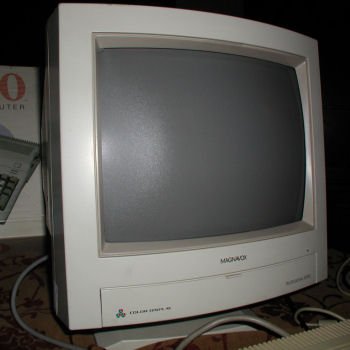Hello everyone! First post, and first day signed up for your lovely forums.
The Story: Okay! So i inherited an old apple LC from a friends basement and this thing is so cool. But it's got a proprietary apple 15Pin Connector for video out. I'd like to run it, but i feel like using VGA is just cheating, no real love for that vintage feel of limited color palettes.
What I DO have: Is a MAGNAVOX CM8762 074G vintage monitor from 1990.
This monitor has two inputs. A CVBS connection, and a RGB TTL port with a special little adapter to run it into a DB9 port. So, I really want to use this old thing for my apple but information is sparse on the LC including workarounds. Everything points me to use a VGA converter, but i really like this monitor because it matches that vintage feel.
So, can i build a converter to make the Macintosh LC use this CGA/ EGA connection? Most forms have told me that RGB TTL is a little different from standard RGB and it's been commonly referred to as CGA.
Service Manual for this Monitor
http://www.msxarchive.nl/pub/msx/mirrors/hanso/service_manuals/philipscm8833sm.pdf
CGA pinout I found
http://old.pinouts.ru/Video/CGA_pinout.shtml
And to clarify this is a first generation Macintosh LC. Not a LCII or LC III Little computer still has a knockout for that dual floppy option, so I've done a little homework on it.
Found this conversion for an apple 2 that may help too. But it's not specifically LC so, i've got no idea if this will even work for me.
http://knut.one/A2E-CGA.htm
Any help is appreciated guys. Also, If the conversion requires something weird I can solder it myself if the instructions are specific enough.
Thanks for your time and I hope you can assist me in this conundrum
___ Radio ____
The Story: Okay! So i inherited an old apple LC from a friends basement and this thing is so cool. But it's got a proprietary apple 15Pin Connector for video out. I'd like to run it, but i feel like using VGA is just cheating, no real love for that vintage feel of limited color palettes.
What I DO have: Is a MAGNAVOX CM8762 074G vintage monitor from 1990.
This monitor has two inputs. A CVBS connection, and a RGB TTL port with a special little adapter to run it into a DB9 port. So, I really want to use this old thing for my apple but information is sparse on the LC including workarounds. Everything points me to use a VGA converter, but i really like this monitor because it matches that vintage feel.
So, can i build a converter to make the Macintosh LC use this CGA/ EGA connection? Most forms have told me that RGB TTL is a little different from standard RGB and it's been commonly referred to as CGA.
Service Manual for this Monitor
http://www.msxarchive.nl/pub/msx/mirrors/hanso/service_manuals/philipscm8833sm.pdf
CGA pinout I found
http://old.pinouts.ru/Video/CGA_pinout.shtml
And to clarify this is a first generation Macintosh LC. Not a LCII or LC III Little computer still has a knockout for that dual floppy option, so I've done a little homework on it.
Found this conversion for an apple 2 that may help too. But it's not specifically LC so, i've got no idea if this will even work for me.
http://knut.one/A2E-CGA.htm
Any help is appreciated guys. Also, If the conversion requires something weird I can solder it myself if the instructions are specific enough.
Thanks for your time and I hope you can assist me in this conundrum
___ Radio ____




